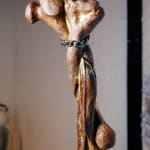Shayne Phua
Further images
The story goes that the great anthropologist, Margaret Mead, was once asked what she considered the earliest sign of human civilization. The response: a healed femur bone that was supposedly 15,000 years old, the reason being that the sufferer of the injury had to have been provided with nourishment, shelter and protection for a sufficient period of time to allow the broken bone to heal, an arrangement that marks the emergence of civilized man. No evidence exists to suggest the veracity of this anecdote – a book published in 1980 apparently makes the earliest mention of it – but the point of the tale, for Phua, is the assumption that altruism and mutual care is the basis of civilization, despite the glaring fact that horrific atrocities have been committed by supposedly civilized societies (a theme also taken up in Burning bridges, bleeding river). The work features a pair of entwined, broken bone fragments, a femur and a humerus, suggesting the moral of the story, which bears relevance for Singapore. The perception of Singaporeans as being rude and uncultured, perhaps an overgeneralization, has resulted in state-sponsored drives such as the National Courtesy Campaign of the 1980s and ‘90s, and the Singapore Kindness Movement of recent years.







